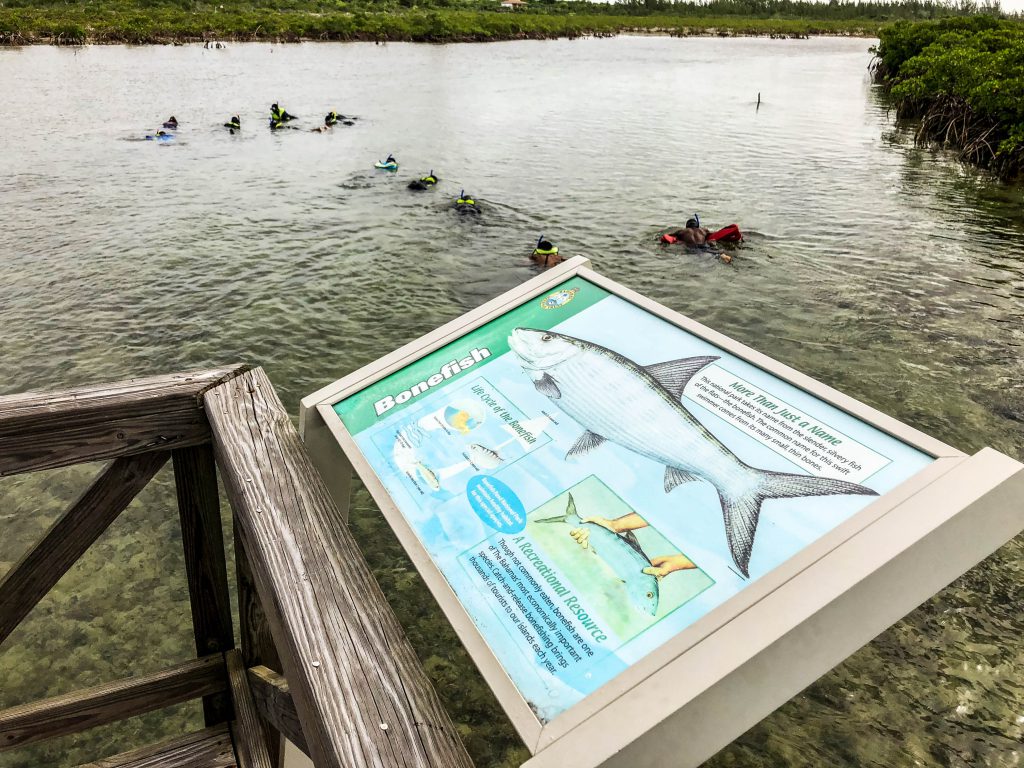This summer, Bahamas Initiative Manager Justin Lewis and intern Nina Sanchez represented Bonefish & Tarpon Trust at the Bahamas Reef Environment Educational Foundation (BREEF) and Royal Bahamas Defense Force Marine Conservation Workshop, sponsored in part by BTT. The week-long workshop, held at the Royal Bahamas Defense Force base in Nassau, gave participants the opportunity to learn about marine conservation and fishery regulations in The Bahamas. The attendees included fisheries, customs and defense force officers, as well as schoolteachers from around The Bahamas.
The diverse group engaged in classroom lectures, which were followed by a range of field trip activities that allowed the participants to apply their new knowledge and understanding of marine life and conservation. Many commented on how much more impactful the information taught in the classroom became after they had seen the ecosystems and organisms firsthand. 
As part of the workshop, BTT led a field trip to Bonefish Pond National Park to explore and snorkel the mangrove ecosystem. Bonefish Pond National Park, a protected coastal wetland area, not only serves as a key habitat for an array of organisms, such as bonefish, but it also acts as a classroom where visitors can observe the mangrove ecosystem from a boardwalk or through a snorkeling mask. In an interactive boardwalk hike, workshop participants learned about the function of mangroves and the vital role they play. While on the hike, Justin pointed out the telltale signs of bonefish, such as feeding holes. With masks and snorkels, the participants then drifted along the mangroves identifying fish, sponges and algae like Laurencia, which are key features of healthy bonefish habitat.
Justin kicked off the afternoon with a presentation about the role of BTT and its Bahamas Initiative. He spoke about bonefish anatomy and their ecological importance, and discussed bonefish reproduction and the interconnectivity of bonefish populations in terms of spawning sites. He then showed the best handling practices video that BTT produced. Finally, Justin presented arguably the most important information for the law enforcement participants in the workshop: the bonefish regulations in The Bahamas. Participants were given the opportunity to ask questions to ensure that they were clear on the regulations. Nina then presented on the Bonefish Tag and Recapture Project, the longest ongoing research study by BTT in The Bahamas. She spoke about the small home range of the species and how important marine protected areas are for bonefish conservation. Many participants did not realize how sensitive bonefish were to anthropogenic threats. Nina stressed how important healthy habitats are to the fishery, and showed BTT’s bonefish habitat video to reinforce this point. She then spoke about the importance of citizen science in conservation and how much more effective BTT research efforts are with the use of fishermen’s ecological knowledge (FEK). Participants began to understand that although fishermen and conservation organizations often have the same goal of conserving the fishery, collaboration between these stakeholders is often difficult, but absolutely necessary. BTT’s collaboration with these groups has helped bridge the gap and brought stakeholders together to work towards the common goal of conserving bonefish and flats habitat.
bonefish reproduction and the interconnectivity of bonefish populations in terms of spawning sites. He then showed the best handling practices video that BTT produced. Finally, Justin presented arguably the most important information for the law enforcement participants in the workshop: the bonefish regulations in The Bahamas. Participants were given the opportunity to ask questions to ensure that they were clear on the regulations. Nina then presented on the Bonefish Tag and Recapture Project, the longest ongoing research study by BTT in The Bahamas. She spoke about the small home range of the species and how important marine protected areas are for bonefish conservation. Many participants did not realize how sensitive bonefish were to anthropogenic threats. Nina stressed how important healthy habitats are to the fishery, and showed BTT’s bonefish habitat video to reinforce this point. She then spoke about the importance of citizen science in conservation and how much more effective BTT research efforts are with the use of fishermen’s ecological knowledge (FEK). Participants began to understand that although fishermen and conservation organizations often have the same goal of conserving the fishery, collaboration between these stakeholders is often difficult, but absolutely necessary. BTT’s collaboration with these groups has helped bridge the gap and brought stakeholders together to work towards the common goal of conserving bonefish and flats habitat.
Enforcement of fishery regulations is always a contentious issue, but one of the best ways enforcement of existing fishery regulations can be achieved is through gaining a better understanding of the ecology of marine habitats and organisms in The Bahamas, which enforcement agencies have sworn to protect. The BREEF and RBDF Workshop was a great example of just how important partnerships between law enforcement and conservation organizations like BTT and BREEF are in the protection of Bahamian waters and the organisms that call the waters home. Photos: Justin Lewis




